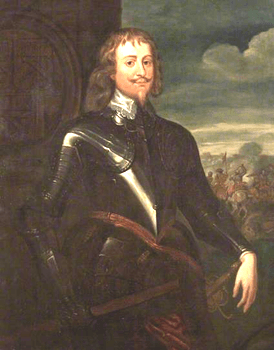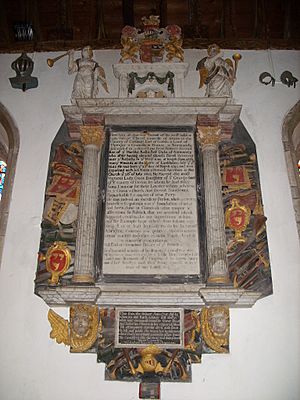Bevil Grenville facts for kids
Quick facts for kids
Sir
Bevil Granville
|
|
|---|---|

Sir Bevil Grenville
|
|
| Member of Parliament for Cornwall |
|
| In office November 1640 – September 1642 (suspended) |
|
| Deputy lieutenant Cornwall | |
| In office 1636–1643 |
|
| Member of Parliament for Launceston |
|
| In office April 1625 – April 1640 |
|
| Member of Parliament for Cornwall |
|
| In office 1620–1624 |
|
| Personal details | |
| Born | 23 March 1596 Lower Brynn, near Withiel, Cornwall |
| Died | 5 July 1643 (aged 47) Charlcombe |
| Cause of death | Killed in battle |
| Resting place | St James, Kilkhampton |
| Nationality | English |
| Spouse | Grace Smith (1618-his death) |
| Parents | Sir Bernard Grenville (1567–1636); Elizabeth Bevil (1564–1636) |
| Alma mater | Exeter College, Oxford |
| Occupation | Soldier and politician |
| Military service | |
| Rank | Colonel |
| Battles/wars | Wars of the Three Kingdoms Braddock Down; Sourton Down; Stratton; Lansdowne † |
Sir Bevil Grenville (born March 23, 1596 – died July 5, 1643) was an English landowner and soldier. He served as a Member of Parliament (a representative in the government) for different areas between 1620 and 1642. When the First English Civil War began in 1642, he joined the Royalists. These were supporters of King Charles I. Sir Bevil played a key role in their early battles in the West of England. He was killed during a battle in 1643.
Who Was Bevil Grenville?
Bevil Grenville was born on March 23, 1596. His birthplace was Lower Brynn, a village near Withiel in Cornwall, England. He was the oldest son of Sir Bernard Grenville and Elizabeth Bevil. His grandfather was the famous Elizabethan naval captain, Sir Richard Grenville. Bevil also had a younger brother named Richard. This brother later fought for the Royalists too.
Bevil went to Exeter College, Oxford in 1611. He finished his studies in 1614. After college, he spent four years at the King's Court. In 1618, Bevil married Grace Smith. Her father, Sir George Smith, was a wealthy businessman and Mayor of Exeter. Bevil and Grace had twelve children together. Some of their children included John, Dennis, Bernard, Elizabeth, Bridget, Joanna, and Grace.
Early Political Life
In 1621, Bevil Grenville was chosen to be a knights of the shire for Cornwall. This meant he represented Cornwall in Parliament. He was elected again in 1624.
In 1625, Bevil took over his family's estates in Kilkhampton. He also agreed to pay off his father's large debts. He was elected to represent Launceston in Parliament that same year. He held this position until King Charles I stopped Parliament from meeting in 1629.
Even though his father supported the King's policies, Bevil supported Sir John Eliot. Eliot was a politician who disagreed with the King. Bevil stopped being involved in politics after Eliot died in 1632. However, he later became friends with his father again. After his father died in 1636, Bevil became a Deputy lieutenant of Cornwall. This was an important local role.
Fighting in the Civil War
In 1639, a war started with Scotland. Even though Bevil had disagreed with the King before, he raised a group of soldiers to protect King Charles. For his service, he was made a knight in 1639. When Parliament met again briefly in 1640, he was re-elected for Launceston. He then represented Cornwall in the Long Parliament until 1642.
When the First English Civil War began in August 1642, many wealthy families in the West of England supported the Royalists. Bevil helped the King gather local soldiers in Launceston. He and other leaders, like Nicholas Slanning and William Godolphin, each created their own regiments. These soldiers were known as "the Tinners." Many of them worked in local tin mines.
Sometimes, soldiers didn't have a choice about joining the army. Bevil was usually a kind landlord. However, he told his tenants and workers they would face problems if they didn't join. The Cornish soldiers were known for not wanting to fight outside Cornwall. They also preferred to fight under Cornish leaders. This made them very good fighters for the Royalists in the West. But it also meant they couldn't always be used far from home. For example, in 1643, many of them refused to cross the River Tamar into Devon.
Key Battles
At the Battle of Stratton on May 16, 1643, Bevil led his men. They attacked Parliamentarian soldiers who were dug in on Stamford hill. After eight hours of fighting, the Royalists were running out of ammunition. A counterattack briefly pushed Bevil's troops back. But they quickly regrouped and fought with pikes and clubs. Soon after, the Parliamentarians ran away. This victory secured Cornwall for the Royalists.
The Royalists then moved into Devon and Somerset. This led to the Battle of Lansdowne on July 5, near Bath. Bevil led his regiment in a successful charge against the Parliamentarian positions on Lansdowne Hill. He then held his ground, even though the Parliamentarian cavalry attacked many times.
During this battle, Bevil was hit in the head. He was taken to a nearby house in Cold Ashton. He died from his wounds the next day. His friend John Trevelyan wrote to Bevil's wife, Grace, saying that Bevil "died an honourable death...fighting with invincible valour and loyalty for his God, his King and his Country." Bevil's servant brought his body back to Kilkhampton. He was buried there on July 26.
Legacy
Bevil's grandson, George Granville, 1st Baron Lansdown, became an important government official in 1710. He chose the title "Baron Lansdown" to honor his heroic grandfather. In 1714, he built a detailed monument to Sir Bevil. This monument was a reminder of his family's loyalty to the King. In 1720, he also built Sir Bevil Grenville's Monument.
|



